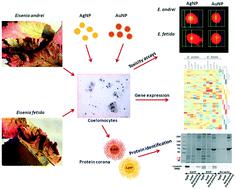当前位置:
X-MOL 学术
›
Environ. Sci.: Nano
›
论文详情
Our official English website, www.x-mol.net, welcomes your
feedback! (Note: you will need to create a separate account there.)
Species-specific sensitivity of Eisenia earthworms towards noble metal nanoparticles: a multiparametric in vitro study
Environmental Science: Nano ( IF 5.8 ) Pub Date : 2020-09-10 , DOI: 10.1039/c9en01405e Kornélia Bodó 1, 2, 3, 4, 5 , Yuya Hayashi 6, 7, 8, 9 , Gellért Gerencsér 3, 4, 5, 10, 11 , Zoltán László 3, 4, 5, 11, 12 , Albert Kéri 11, 13, 14, 15, 16 , Gábor Galbács 11, 13, 14, 15, 16 , Elek Telek 3, 4, 5, 11, 17 , Mária Mészáros 11, 16, 18, 19 , Mária A. Deli 11, 16, 18, 19 , Bohdana Kokhanyuk 1, 2, 3, 4, 5 , Péter Németh 1, 2, 3, 4, 5 , Péter Engelmann 1, 2, 3, 4, 5
Environmental Science: Nano ( IF 5.8 ) Pub Date : 2020-09-10 , DOI: 10.1039/c9en01405e Kornélia Bodó 1, 2, 3, 4, 5 , Yuya Hayashi 6, 7, 8, 9 , Gellért Gerencsér 3, 4, 5, 10, 11 , Zoltán László 3, 4, 5, 11, 12 , Albert Kéri 11, 13, 14, 15, 16 , Gábor Galbács 11, 13, 14, 15, 16 , Elek Telek 3, 4, 5, 11, 17 , Mária Mészáros 11, 16, 18, 19 , Mária A. Deli 11, 16, 18, 19 , Bohdana Kokhanyuk 1, 2, 3, 4, 5 , Péter Németh 1, 2, 3, 4, 5 , Péter Engelmann 1, 2, 3, 4, 5
Affiliation

|
Two closely-related earthworm species (Eisenia spp.) have long been used as model organisms in ecotoxicology. The same nanoparticles (NPs) may affect the two species differently, not only because of the inherent differences in susceptibility but also due to how the immune system could recognize NPs. In a comparative approach using E. andrei and E. fetida, we study various immune-related parameters of earthworm coelomocytes following in vitro exposure to 10 nm NPs (silver, Ag; and gold, Au) or dissolved Ag (AgNO3). In general, E. fetida coelomocytes were more susceptible to AgNPs and AgNO3 while AuNPs did not show cytotoxicity. At the sub-cellular level, AgNPs similarly affected cellular redox reactions in both species; however, E. fetida showed greater responses for apoptosis-related endpoints. At the molecular level, AgNPs (at 24 h LC20) induced a significantly high level of superoxide dismutase in E. andrei coelomocytes while E. fetida was additionally characterized by consistent induction of metallothionein and differential capacity for redox/metal regulation. Although AuNPs were not cytotoxic, both NP types (Ag and Au) seemed to alter the expression pattern of immune-related genes (toll-like receptor and lysenin) in both species, but more clearly in E. fetida. We further observed that lysenin proteins, while secreted differentially between the two species, bind only to AgNPs resulting in negative secretion feedback. Our findings support the general preference for E. fetida in ecotoxicology, and reveal the potential roles of protective and immune mechanisms optimized for each species in its own ecological niche.
中文翻译:

ise对贵金属纳米粒子的物种特异性敏感性:多参数体外研究
长期以来,两种密切相关的earth物种(Eisenia spp。)已被用作生态毒理学中的模型生物。相同的纳米粒子(NPs)可能对这两个物种的影响不同,这不仅是由于敏感性的内在差异,还因为免疫系统如何识别NPs。在使用E. andrei和F. fetida的比较方法中,我们研究了体外暴露于10 nm NPs(银,Ag和金,Au)或溶解的Ag(AgNO 3)后worm体粒细胞的各种免疫相关参数。总体而言,fetida肠埃希氏菌对AgNPs和AgNO 3更敏感而AuNPs没有显示出细胞毒性。在亚细胞水平上,AgNPs同样影响两种物种的细胞氧化还原反应。然而,fetida E.显示出对凋亡相关终点的更大反应。在分子水平,的AgNPs(在24小时LC 20)诱导的显著高水平超氧化物歧化酶在E.安德烈体腔而赤子爱胜蚓被加特征在于一致诱导金属硫蛋白和氧化还原/金属调控微分电容。尽管AuNPs没有细胞毒性,但是两种NP类型(Ag和Au)似乎都改变了免疫相关基因(toll样受体和lysenin)的表达模式)在两个物种中,但在f。fetida中更清楚。我们进一步观察到,虽然在两个物种之间分泌的lysenin蛋白不同,但它们仅与AgNPs结合,从而导致负分泌反馈。我们的研究结果支持在生态毒理学中普遍优先使用fet fetida,并揭示了针对每个物种在其自身生态位中优化的保护和免疫机制的潜在作用。
更新日期:2020-11-03
中文翻译:

ise对贵金属纳米粒子的物种特异性敏感性:多参数体外研究
长期以来,两种密切相关的earth物种(Eisenia spp。)已被用作生态毒理学中的模型生物。相同的纳米粒子(NPs)可能对这两个物种的影响不同,这不仅是由于敏感性的内在差异,还因为免疫系统如何识别NPs。在使用E. andrei和F. fetida的比较方法中,我们研究了体外暴露于10 nm NPs(银,Ag和金,Au)或溶解的Ag(AgNO 3)后worm体粒细胞的各种免疫相关参数。总体而言,fetida肠埃希氏菌对AgNPs和AgNO 3更敏感而AuNPs没有显示出细胞毒性。在亚细胞水平上,AgNPs同样影响两种物种的细胞氧化还原反应。然而,fetida E.显示出对凋亡相关终点的更大反应。在分子水平,的AgNPs(在24小时LC 20)诱导的显著高水平超氧化物歧化酶在E.安德烈体腔而赤子爱胜蚓被加特征在于一致诱导金属硫蛋白和氧化还原/金属调控微分电容。尽管AuNPs没有细胞毒性,但是两种NP类型(Ag和Au)似乎都改变了免疫相关基因(toll样受体和lysenin)的表达模式)在两个物种中,但在f。fetida中更清楚。我们进一步观察到,虽然在两个物种之间分泌的lysenin蛋白不同,但它们仅与AgNPs结合,从而导致负分泌反馈。我们的研究结果支持在生态毒理学中普遍优先使用fet fetida,并揭示了针对每个物种在其自身生态位中优化的保护和免疫机制的潜在作用。











































 京公网安备 11010802027423号
京公网安备 11010802027423号